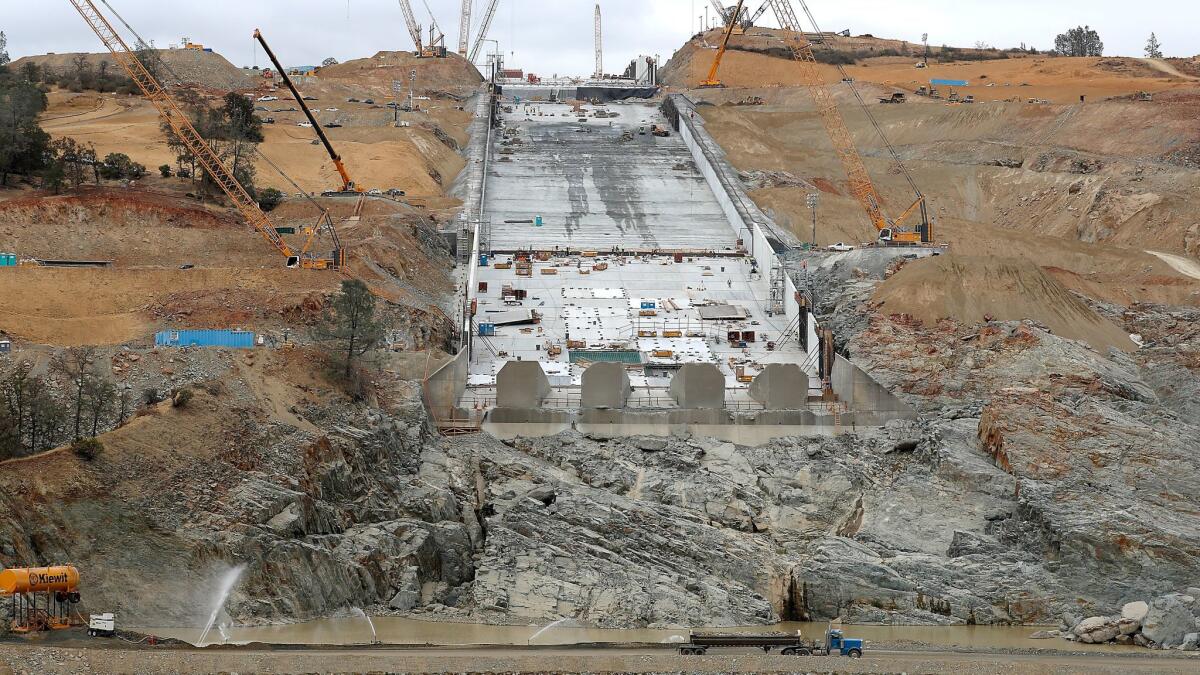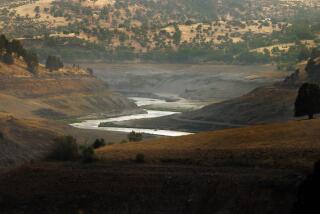Racing to repair the Oroville Dam spillway — before the rains come

- Share via
Reporting from Oroville, Calif. — In one of the fastest-paced civic construction jobs in recent U.S. history, hundreds of carpenters, operating engineers and iron workers are rushing to complete repairs to the damaged Oroville Dam spillway.
The crews are trying to beat a Nov. 1 deadline and the Northern California rainy season, which once again will begin to fill the massive reservoir behind the nation’s highest dam.
About 700 construction workers, backed by teams of engineers at the Department of Water Resources, are working in shifts 22 hours a day — building forms, laying steel reinforcement rods and pouring concrete in the damaged middle and lower sections of the chute.
When the repairs are completed, the 3,000-foot-long spillway will have concrete slabs thicker than a runway, reinforcement rods and thousands of anchors epoxied at least 15 feet deep into rock — making it significantly stronger than the original 1960s design.
“This is not a Band-Aid,” said Jeff Petersen, the project director and senior vice president at construction giant Kiewit Corp. “You might as well do it right.”
The spillway was beaten to pieces in February, when a series of powerful rainstorms in the Feather River watershed filled the reservoir to its brink, forcing operators to open the gates and send more water down the chute than flows over Niagara Falls on average, rushing at freeway speeds some 12 feet deep.
A panel of investigators believes the water penetrated the spillway’s massive concrete slabs and heaved them upward, causing the dam’s foundation to fall apart.
By the time the storms ended, two massive craters had been scoured into the metamorphic rock. Engineers dubbed the bigger, 80-foot-deep void “Hell’s Canyon.”
State engineers immediately began designing the repairs and gave Kiewit a formal “notice to proceed” on April 21. Actual work started May 20, after the company was able to mobilize 500 pieces of construction equipment, build a concrete batch plant and hire the specialized workers it would need.
The company is “burning” through about $1 million a day, a ferocious rate of spending in the construction industry, Petersen said.
The new concrete slabs on the spillway floor are at least 5 feet thick, compared with a minimum of 18 inches in the old chute, Petersen said. In some sections, workers are filling voids tens of feet deep with concrete. Crews are cleaning up hillside bedrock with picks and vacuums to ensure a good bond.
By the time repairs are fully completed next year, the entire spillway will be new except for the gate control structure. The original estimate came in at $275 million, but it now looks like the tab will hit $500 million, said Erin Mellon, a Department of Water Resources spokeswoman.
The cost increase reflects much greater damage to the foundation that was discovered once work began, Petersen said. The original design called for about 485,000 cubic yards of concrete, but as excavation of the loose rock proceeded, that was increased to 870,000 cubic yards.
The spillway repair will extend through next year.
Kiewit is fully rebuilding an 870-foot section of the middle spillway and a 350-foot section at the bottom with high-strength concrete. It is using a fast-setting pavement, known as roller compacted concrete, along an additional 1,050-foot section in the middle that will be upgraded next year. The upper 730 feet also will be repaired next year.
Mellon said the agency was being conservative with its Nov. 1 date to complete repairs.
On Thursday, the lake was 113 feet below the spillway gates. It would take rainstorms that deposit 1 million acre-feet of water into the lake before it would even come up to the level of the gates. In the meantime, operators are continuing to drain 3,000 cubic feet of water per second through the dam’s power plant, sending electricity to the California grid.
In addition to the main spillway, Kiewit is repairing the equally troubled emergency spillway. When the main chute was damaged in February, operators shut it down and let water overflow the emergency spillway.
It was the first time in the dam’s history that it had been used — and it stood up to the challenge for less than a day before entire sections of the mountainside began eroding toward a crucial weir that held back 30 vertical feet of water. Operators quickly resumed using the main spillway, adding to the damage there.
The Department of Water Resources designed a 1,450-foot-long underground wall to stabilize the mountainside, and plans to lay 10 feet of concrete on top of the hillside from the spillway weir to the underground wall.
Robert Bea, a retired UC Berkeley civil engineer and member of the National Academy of Engineering, said Kiewit and Water Resources were “making good progress” and that the “spillways should be ready for intended purposes for the end of this year and early next year.”
But Bea, who issued an independent analysis of the spillway failure, said the gate structure has large cracks in its concrete and other problems. State officials said they were paying close attention to the structure and believe it is in sound condition.
Follow me on Twitter @rvartabedian
More to Read
Sign up for Essential California
The most important California stories and recommendations in your inbox every morning.
You may occasionally receive promotional content from the Los Angeles Times.











